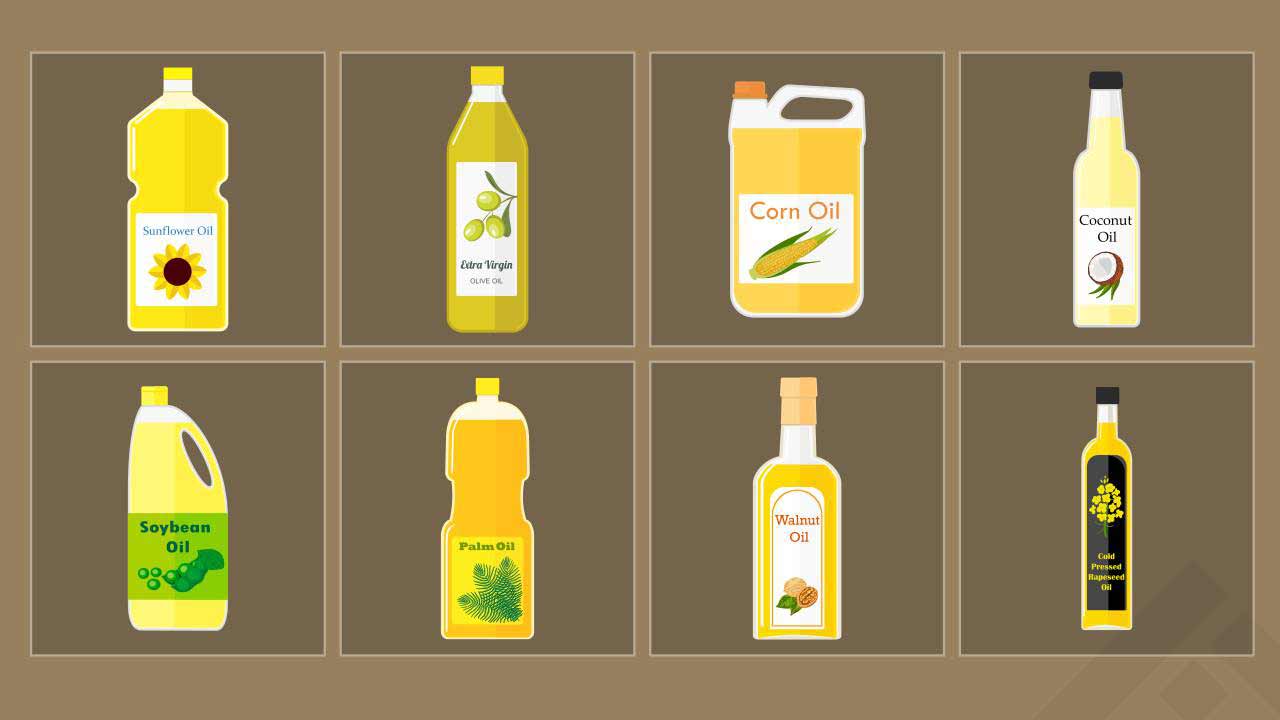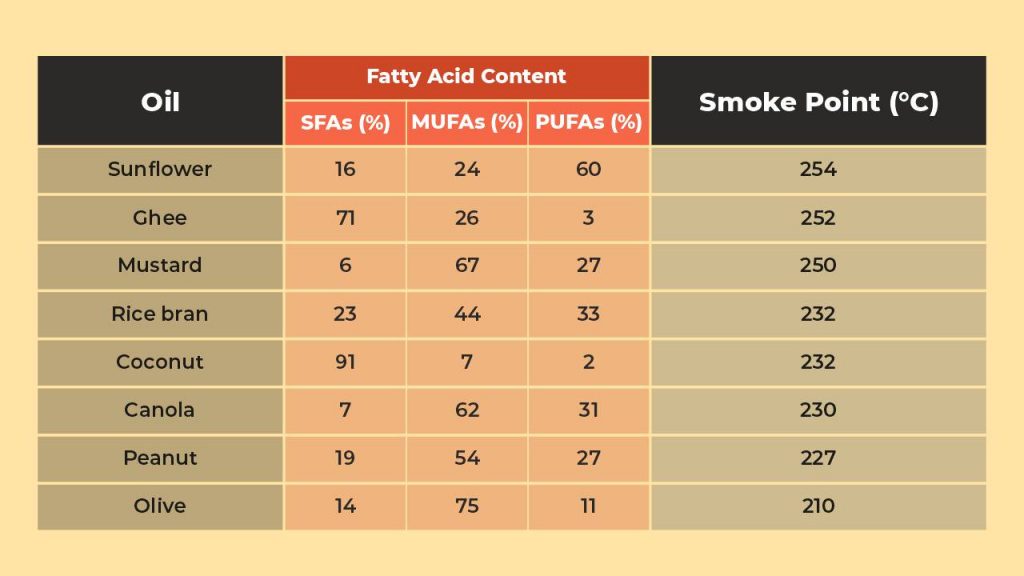
Cooking Oils: How to Make a Healthy Choice

Cooking oil not only affects the flavor of your food, but also influences the nutritional content of your diet. With so many different oils on the shelves, how should you decide which one is right for you? Here’s a ready guide to healthy cooking oils to help you make an informed choice the next time you cook.
What are cooking oils made of?
All cooking oils are different mixtures of saturated fatty acids (SFAs), monounsaturated fatty acids (MUFAs), and polyunsaturated fatty acids (PUFAs). It’s important to exercise caution when consuming SFAs as they increase the amount of cholesterol in your blood which may cause heart diseases, obesity, and diabetes. MUFAs and PUFAs, on the other hand, help in maintaining healthy cholesterol levels and are hence safer.
Cooking oils also contain essential fatty acids, like omega-6 and omega-3, which cannot be produced by the body. According to the World Health Organization (WHO), cooking oils, which have a good balance of these fatty acids — a ratio of 5:1 — are healthy. An excess of omega-6 may cause inflammation in the body and lead to diseases like diabetes and high blood pressure.
Smoke point of cooking oils
Every oil has a different smoke point, which is the temperature at which it begins to break down and smoke. It’s a good idea to not heat oils above their smoke point as it reduces beneficial nutrients and produces harmful chemicals. If it starts producing fumes and darkening the sides of the cooking vessel, the oil is burning.
Choose your cooking oil carefully for the dish you want to make and the type of cooking it needs:
- Oils with a high smoke point (around 250°C) can be used for deep-frying, shallow-frying and roasting
- The oils with a medium smoke point (around 230°C) are ideal for sautéing and stir-frying for short durations
- Oils having a low smoke point (around 200°C) are preferable for garnishing and salad dressing
Different cooking methods need different oils
Indian cooking mostly involves preparing food on high to medium-high heat. Let’s find out about healthy oils for Indian cooking.
1. Deep or shallow frying
Deep or shallow frying requires the food item to be submerged completely or partially in hot oil. Here, the oil is subjected to high heat (up to 205°C) for a long time. That said, deep or shallow frying food is not a healthy cooking practice and should only be done in moderation.
Oils to use for deep and shallow frying are:
Mustard oil
Pros: Mustard oil is not only a good source of MUFA and omega-3, but also contains a compound called allyl isothiocyanate, which may be beneficial against inflammatory diseases.
Cons: Unrefined mustard oil contains a fatty acid called erucic acid, which can be toxic for the heart. So, it’s best to opt for refined mustard oil for cooking your daily food. If you choose the unrefined variety, do so sparingly.
Sunflower oil
Pros: Sunflower oil is the richest source of PUFAs and vitamin E, and is low in SFAs.
Cons: It has a very poor ratio of omega-6 to omega-3 fatty acids, so consuming it in large quantities may increase the risk of diabetes and heart ailments.
Clarified butter (ghee)
Pros: It contains plentiful amounts of vitamins A, D, E, and K, and butyrate, a fatty acid that may help in digestion and soothing intestinal inflammation.
Cons: It has high levels of SFAs and naturally occurring trans-fatty acids (TFAs). So, limit your ghee intake to not more than one tablespoon a day.
2. Stir-frying and sautéing
Stir-frying and sautéing involve cooking the food by tossing it in a small quantity of oil — usually one to two teaspoons per person — at medium-high heat (approx 160°C) for a relatively short time. Most Indian curries and vegetable dishes (sabzi) require stir-frying and sautéing.
Oils to use for stir-frying and sautéing:
Canola oil
Pros: It is touted as one of the healthiest cooking oils for the heart as it contains minimal SFAs, abundant MUFAs, and a perfect balance of omega-6 and omega-3.
Cons: Nil
Peanut oil
Pros: Peanut oil has abundant good fatty acids, vitamin E and resveratrol, which may protect against certain cancers and heart diseases.
Cons: It has a poor ratio of omega-6 to omega-3 fatty acids and is allergenic.
Rice bran oil
Pros: Rice bran oil is hypoallergenic, making it a great option for people with food allergies. Its low density means you will use less of it when cooking, reducing overall calories.
It has abundant vitamin E and good fatty acids. It also contains oryzanol, a powerful antioxidant proven to reduce heart disease risk factors.
Cons: Nil
Coconut oil
Pros: It is rich in medium-chain fatty acids, which may help treat epilepsy and Alzheimer’s disease. Vegans can use it as a substitute for ghee.
Cons: Due to high levels of SFAs, it is advisable to have coconut oil sparingly.
3. Garnishing and dressing
Garnishing involves drizzling a small amount of oil on top of a cooked dish to enhance its flavor, while dressing refers to coating a food preparation (usually salads) in oil. Oils aren’t subjected to heat in these methods.
Olive oil is a great option for garnishing and dressing.
Olive oil
Pros: Olive oil has the highest amount of MUFAs and is widely known to lower the risk of heart disease, obesity, and diabetes. Research suggests that extra virgin olive oil may even be useful for treating depression and anxiety.
Cons: Due to its fruity flavor and low smoke point, it is best to avoid olive oil for Indian cooking. It is usually used for garnishing and dressing dishes, but can also be used to sauté food for a short time.

How to select a healthy cooking oil?
Since all cooking oils have a different nutrient composition, it is best to use a combination of oils in your dishes. The best practice is to switch between oils for each meal. This will allow you to get the required daily amount of all fatty acids and vitamins, and also to maintain a balance of omega-6 and omega-3 in your diet.
For example, you can use mustard oil (rich in MUFAs and omega-3) in rotation with sunflower oil (rich in PUFAs and omega-6) and ghee (rich in SFAs and vitamins A, D, E, and K). However, mixing cooking oils, and using blended oil is not advisable due to their different smoke points.
The recommended allowance of oil for healthy adults is 15ml or three teaspoons a day, which is about ½ liter a month. Moderation is key when it comes to consuming cooking oils.
Also read: Dietary Fats: How to Choose Right and Eat Smart
What is refined oil?
Oils are refined to increase their smoke points, but this reduces their nutrient levels and flavor. It also increases their TFA, which may lead to an increased risk of cancer and heart disease.
Unrefined oils, also known as virgin, cold-pressed oils are extracted by mechanical methods at low temperatures. They retain their natural flavors and nutrients and also maintain low smoke points.
Guide to using cooking oil
1. Heat oils below their smoke points to avoid loss of nutritional value. Oils with high smoke points are considered healthy oils for Indian cooking.
2. Use MUFA and omega-3 rich oils to maintain good heart health and reduce the risk of diabetes and hypertension.
3. Use different oils in rotation to get all types of nutrients and to derive maximum health benefits.
4. Use only recommended amounts of oils for cooking to avoid health problems.
5. Choose mostly unrefined oils to gain maximum nutrition and flavor, and to avoid harmful TFAs.
References
1. Dorni C, Sharma P, Saikia G, et al. Fatty acid profile of edible oils and fats consumed in India. Food Chem 2018; 238: 9–15.
2. DiNicolantonio JJ, O’Keefe JH. Importance of maintaining a low omega-6/omega-3 ratio for reducing inflammation. Open Heart 2018; 5: e000946.
3. Chatterjee P, Fernando M, Fernando B, et al. Potential of coconut oil and medium chain triglycerides in the prevention and treatment of Alzheimer’s disease. Mech Ageing Dev 2020; 186: 111209.
4. Mishra S and Manchanda SC. Cooking oils for heart health. Journal of Preventive Cardiology 2012; 1: 123–131.
5. Narasimhan S, Nagarajan L, Vaidya R, et al. Dietary fat intake and its association with risk of selected components of the metabolic syndrome among rural South Indians. Indian J Endocrinol Metab 2016; 20: 47–54.














